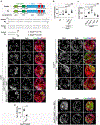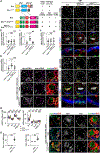mRNA decay pre-complex assembly drives timely cell-state transitions during differentiation
- PMID: 39739530
- PMCID: PMC11911916
- DOI: 10.1016/j.celrep.2024.115138
mRNA decay pre-complex assembly drives timely cell-state transitions during differentiation
Abstract
Complexes that control mRNA stability and translation promote timely cell-state transitions during differentiation by ensuring appropriate expression patterns of key developmental regulators. The Drosophila RNA-binding protein brain tumor (Brat) promotes the degradation of target transcripts during the maternal-to-zygotic transition in syncytial embryos and uncommitted intermediate neural progenitors (immature INPs). We identify ubiquitin-specific protease 5 (Usp5) as a candidate Brat interactor essential for the degradation of Brat target mRNAs. Usp5 promotes the formation of the Brat-deadenylase pre-complex in mitotic neural stem cells (neuroblasts) by facilitating Brat interactions with the scaffolding components of deadenylase complexes. The adaptor protein Miranda binds the RNA-binding domain of Brat, limiting its ability to bind target mRNAs in mitotic neuroblasts. Cortical displacement of Miranda activates Brat-deadenylase complex activity in immature INPs. We propose that the assembly of an enzymatically inactive and RNA-binding-deficient pre-complex poises mRNA degradation machineries for rapid activation, driving timely developmental transitions.
Keywords: Brat; CP: Developmental biology; CP: Molecular biology; Drosophila; Usp5; cell state transitions; deadenylase complexes; differentiation; mRNA decay; maternal mRNAs; neuroblast.
Copyright © 2024 The Author(s). Published by Elsevier Inc. All rights reserved.
Conflict of interest statement
Declaration of interests The authors declare no competing interests.
Figures







Update of
-
Post-transcriptional regulatory pre-complex assembly drives timely cell-state transitions during differentiation.bioRxiv [Preprint]. 2024 Apr 30:2024.04.29.591706. doi: 10.1101/2024.04.29.591706. bioRxiv. 2024. Update in: Cell Rep. 2025 Jan 28;44(1):115138. doi: 10.1016/j.celrep.2024.115138. PMID: 38746105 Free PMC article. Updated. Preprint.
Similar articles
-
Post-transcriptional regulatory pre-complex assembly drives timely cell-state transitions during differentiation.bioRxiv [Preprint]. 2024 Apr 30:2024.04.29.591706. doi: 10.1101/2024.04.29.591706. bioRxiv. 2024. Update in: Cell Rep. 2025 Jan 28;44(1):115138. doi: 10.1016/j.celrep.2024.115138. PMID: 38746105 Free PMC article. Updated. Preprint.
-
Brain tumor specifies intermediate progenitor cell identity by attenuating β-catenin/Armadillo activity.Development. 2014 Jan;141(1):51-62. doi: 10.1242/dev.099382. Epub 2013 Nov 20. Development. 2014. PMID: 24257623 Free PMC article.
-
Brain tumor is a sequence-specific RNA-binding protein that directs maternal mRNA clearance during the Drosophila maternal-to-zygotic transition.Genome Biol. 2015 May 12;16(1):94. doi: 10.1186/s13059-015-0659-4. Genome Biol. 2015. PMID: 25962635 Free PMC article.
-
Analysis of neural stem cell self-renewal and differentiation by transgenic RNAi in Drosophila.Arch Biochem Biophys. 2013 Jun;534(1-2):38-43. doi: 10.1016/j.abb.2012.08.003. Epub 2012 Aug 13. Arch Biochem Biophys. 2013. PMID: 22906721 Review.
-
Molecular and biological functions of TRIM-NHL RNA-binding proteins.Wiley Interdiscip Rev RNA. 2021 Mar;12(2):e1620. doi: 10.1002/wrna.1620. Epub 2020 Aug 1. Wiley Interdiscip Rev RNA. 2021. PMID: 32738036 Free PMC article. Review.
References
Publication types
MeSH terms
Substances
Grants and funding
LinkOut - more resources
Full Text Sources
Molecular Biology Databases
Research Materials
Miscellaneous

